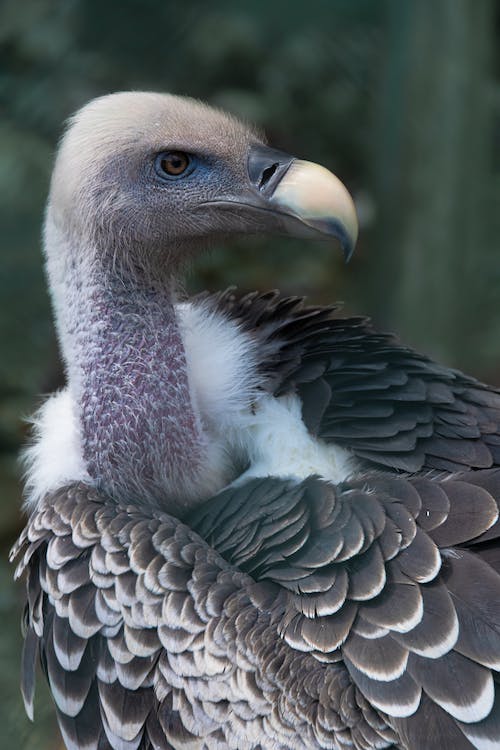It is a medium-sized, generally dark vulture with a naked, forked, pale pink to whitish head, and huge pinkish-orange beak. It is often one of the first vulture species to feast on carrion but will scavenge eagle kills, though it may sometimes hunt small birds, mammals, and reptiles.
Read further to know more about the White-headed Vulture.
What is a White-headed Vulture?
White-headed Vulture is an Old World vulture species only found in Africa. While endemic, the population of this bird has experienced a cataclysmic decline in the last three generations, which is estimated to be at an average of 96%. Its extinct close cousin, which occurs in Flores Island in Indonesia, suggests that the genus was even more spread out in the past.
Its seven levels of classification are as follows:
Kingdom: Animalia
Phylum: Chordata
Class: Aves
Order: Accipitriformes
Family: Accipitridae
Genus: Trigonoceps
Species: T. occipitalis
White-headed Vulture Physical Description
White-headed vulture sports an old-fashioned look, growing from 28 to 32 inches or 72 to 82 centimeters, and weighing 4000 grams to 4700 grams, with a wingspan of up to 90 inches or 230 centimeters.
This bird has a dark brown plumage, including the breast band and neck ruff. Its throat, lower breast, belly, and thighs are whitish. Meanwhile, its wide wings are brown, accentuated by white edges in the middle upperwing tetrices. A white band can be observed on the underwing coverts. Tail and flight feathers are black.
White-headed vulture has a wide, forked, unfeathered head, where it got its name. A white wash can be seen on its nape and crown, producing a slight crest. Its eyes are surrounded by bare pinkish skin, until the cheeks and its foreneck.
These birds’ hooked beaks are pinkish-orange with a black tip. Their eyes are small and of a paler orange tone. Meanwhile, their talons and bare legs are coral.
Both sexes are similar in size, but females have white secondary feathers, while males tend to have darker tones. Their juveniles or immature birds are dark brown with white to brownish heads and white speckles on their mantles. It may take nearly six years for them to acquire mature plumage.
Where can they be spotted?
White-headed vultures thrive in open thorn veldts, scanty wooded grassland, and treed savannas. While they are mainly considered as lowland species, they can be found up to 4,000 meters when searching for food.
These birds are widely spread throughout the countries of sub-Saharan Africa and can be found starting from Senegal to Somalia, South Africa, and Swaziland. The Kruger National Park and nearby conservation areas hold the largest population of white-headed vultures in South Africa.
Interesting Facts You Should Know About the White-headed Vulture
White-headed Vultures are primarily a scavenger, feasting on the skin, bone fragments, and tissues of dead animals. Often, they will also steal kills from eagles and the Marabou stork.
While its diet predominantly consists of carcasses, it may also eat live food. Often, these birds will raid other birds’ nests, eat their eggs, or catch other small mammals, reptiles, and stranded fish and amphibians. Insects are no exception as they will also feed on locusts, grasshoppers, and termites. They often arrive first at the carrion site though they are not the dominant vulture species and will often wait for superior birds to finish.
White-headed vultures’ digestive system is brimmed with corrosive and potent stomach acid. They also have high amounts of antibodies against anthrax, salmonella, cholera, and botulism, allowing them to consume putrid and bacteria-infested meals.
These birds are also relatively light, which is perfect for soaring. They only spend small amounts of energy, enabling them to travel and search for food at great distances. These birds are blessed with mobility and agility, with their wings not needing to be flapped vigorously in thermals.
White-headed vultures’ facial skin is said to be brought by evolution as it is more manageable to clean than feathers, which is beneficial as they munch on rotting carrions. Moreover, it functions as an excellent thermal regulator. It effectively radiates heat away and keeps their body temperature down as blood vessels lie underneath the bare facial skin. Then, it is also indicative of the bird’s mood, turning red when they get excited.
These birds breed in pairs. Its courtship display usually consists of circling above their chosen breeding ground or sitting near the nest. White-headed vultures construct their nest mostly on flat-crowned trees, such as acacia. Branches compose the nest exterior while grass lines the interior. The female lays one egg, which the parents jointly incubate for 51 to 56 days. After hatching, the chick will fledge in about four months.
White-headed vultures’ population is affected by poisoned baits, destruction of habitat, and removal of vegetation. It was classified as a vulnerable species in 2007 under the IUCN Red List but had a status upgraded to critically-endangered in 2015.
WILDLIFE PARKS AND RESERVES WHERE THIS SPECIES IS FOUND:
BOTSWANA
SOUTH AFRICA
Kalahari Gemsbok National Park
NAMIBIA
ZAMBIA
ZIMBABWE
BOTSWANA BIRDS | SOUTH AFRICA BIRDS
NAMIBIA BIRDS | ZAMBIA BIRDS | ZIMBABWE BIRDS

